The rocker is a longitudinal sectional view showing the curve of the underside of the board along the central strut (stringer).

The curve of the bottom of the board in contact with the surface must be adapted to the curve of the wave. A perfect rocker for a big wave may be too weak in a small hollow wave..
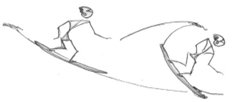
In a straight trajectory, a strong rocker produces more drag than a weak rocker. A flat area under the board decreases the drag of fast boards.
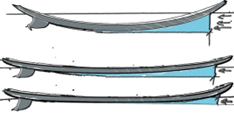
Provided that the flat area corresponds to the wide bearing area where the center of gravity can be applied without sinking the board.
The rocker provides maneuverability in cut curves, in support on the bottom turn type rail. The curve of the turn, mainly generated by the roll inclination which projects a resultant of lift towards the inside of the turn, is influenced by the curve of the rocker, the more the rocker is marked the tighter the curve will be. In curved trajectory the rocker is therefore favorable.
You can use the flexibility of the board to combine effective flat rocker in a straight line when the central supports are light, and a flex curving the rocker under the pressure of a correctly thought out support in the bottom… The correct flex reveals great control shaper and icer. They must take into account the weight and style of the surfer and have a perfect knowledge of the deformations according to the materials used.

The rocker also allows more or less sensitive angle of attack control. The "Staged rocker" is a rocker with one or more flat areas. A large flat area makes the board less sensitive to front-to-back weight shifts, it will take a wider movement to transfer support, while a continuous rocker allows a gradual variation in the angle of incidence under the weight transfer. It is possible to create flat areas that mark incidence levels that will automatically adjust the board to angles studied by the shaper as being the most effective.
The surfer will feel his board stabilize naturally in incidence on these flat areas, he can then concentrate on other objectives, his board will gain in intuitiveness, provided that these flats are correctly sized, because trim angles (incidence ) imposed can be annoying, in this case the intuitiveness disappears.
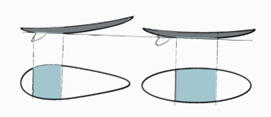
To achieve good intuitiveness of incidence stabilized by flat areas, it is wise to match these areas with the outline: A board designed to be fast will have advanced supports, with a flat on the wide point area also advanced . A tail-focused maneuvering board will benefit from having a slight flat on the wide area of the tail to avoid too much tilting, slowing the board at the tail, the board will be able to stabilize at the tail and the maneuver will be effective. without having to manage the support transfers too precisely. It will of course be necessary that the surface of the tail be designed sufficiently wide and supporting to consolidate the choice of the flat zone. The flat area can of course be slightly curved to adjust the effect. The shaper thus indicates to the surfer the ideal position, by creating a feeling of stability which will be considered intuitive by the surfer. The board expresses itself and thus speaks to the surfer.
 We have seen that the rocker is useful in carved turns, where it serves as a guide curve guiding the trajectory, but that it can be harmful in phases where its curve generates a frontal surface producing drag..
We have seen that the rocker is useful in carved turns, where it serves as a guide curve guiding the trajectory, but that it can be harmful in phases where its curve generates a frontal surface producing drag.. ![]()
The submerged part of the board varies according to the wave phases. The central part of the web of the board does not serve as a guide in the curve of the bottom turn because only the lateral zone is submerged.
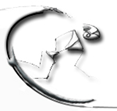 If our board is made to evolve in small waves, a strong rocker in the center for the wave descent phases will be perfect, and for the turn on the rail the same rocker will also be perfect. We can therefore have a bottom of the board that will have the same rocker on the edges as in the center without losing performance. This gives for example for this Fish, cut for small waves, a flat bottom almost over the entire length (view from the center)
If our board is made to evolve in small waves, a strong rocker in the center for the wave descent phases will be perfect, and for the turn on the rail the same rocker will also be perfect. We can therefore have a bottom of the board that will have the same rocker on the edges as in the center without losing performance. This gives for example for this Fish, cut for small waves, a flat bottom almost over the entire length (view from the center) 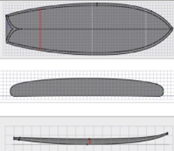
 If our board is made to evolve in larger wave curvatures, we will have to apply more rocker in the rail zones in action in the cut turns, than on the central web to obtain trajectories of tighter carves. . We therefore have an interest in considering the rocker in several areas. For example a very weak rocker on the central zone of the web with even a flat to limit the drag, and a stronger rocker on certain zones of rail to increase the guiding curve in the cut turns.
If our board is made to evolve in larger wave curvatures, we will have to apply more rocker in the rail zones in action in the cut turns, than on the central web to obtain trajectories of tighter carves. . We therefore have an interest in considering the rocker in several areas. For example a very weak rocker on the central zone of the web with even a flat to limit the drag, and a stronger rocker on certain zones of rail to increase the guiding curve in the cut turns.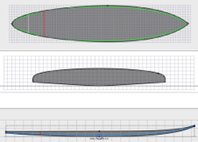 The bottom (cut perpendicular to the stringer) of this "gun" cut in a V on the back, therefore gives more accentuated rockers on the edges than in the middle of the board, it will then combine good performance in turns and in the straight line.
The bottom (cut perpendicular to the stringer) of this "gun" cut in a V on the back, therefore gives more accentuated rockers on the edges than in the middle of the board, it will then combine good performance in turns and in the straight line.
The variation of the rocker according to the area of the board therefore necessarily leads to a non-flat bottom shape. The rocker curves described so far therefore represent longitudinal sections of boards parallel to the central core of the board.
 But we know that the board navigates in a variable relative flow, and in a variable position too, where only part of the bottom is submerged. The relative trajectory of the fluid around the board therefore very rarely follows the centerline of the board. Our board reveals a "hydrodynamic" shape different from its static shape. The hydrodynamic study of surfing therefore consists in taking into account the interaction of the moving fluid with the shapes of the board actually perceived by the fluid in order to correctly quantify the forces in action in a given phase.
But we know that the board navigates in a variable relative flow, and in a variable position too, where only part of the bottom is submerged. The relative trajectory of the fluid around the board therefore very rarely follows the centerline of the board. Our board reveals a "hydrodynamic" shape different from its static shape. The hydrodynamic study of surfing therefore consists in taking into account the interaction of the moving fluid with the shapes of the board actually perceived by the fluid in order to correctly quantify the forces in action in a given phase.
MEASUREMENT OF ROCKER AND MEASUREMENTS IN GENERAL: THE ADIMENSIONAL APPROACH
To measure the rocker, at the core of the board, place a ruler on the underside of the board, tangent to the bottom at the wide point, and measure the vertical distance between the board and the ruler. But the inclination of this ruler in relation to the curved surface of the bottom can vary because it is difficult to estimate the tangency (perpendicular contact) of a line on a curve.
A direction line (line 1) passing through 2 points around the wide point (here at -500mm and + 500mm) can be used.
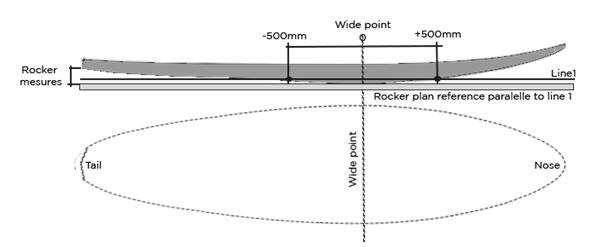
The rocker measurement methods vary according to the references, the method taking 2 reference points around the wide point is one of the most rigorous that is applied, but none allows the comparative approach forging the vision of a professional shaper: If the shaper wants to modify the size of a board, and i want to compare his new rocker with his reference board, this method will give unusable measurements, because if the guideline of the ruler is built on a constant distance between points, the The inclination of the ruler varies according to the nonsymmetrical curvature around the wide point.
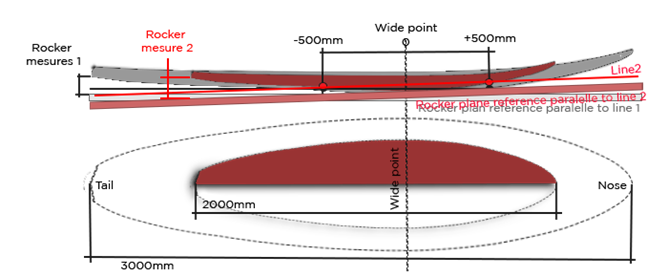 La méthode with constant distance around the wide point to align the ruler gives comparable rockers only on the same board length, but becomes wrong when changing board sizes. The shaper loses the comparative analysis, he will thus be able to find higher tail rocker values for a smaller board: In order not to remain stuck indefinitely in these errors which prevent him from evolving towards a global vision of the shaper must adopt an “adimensional” vision. The method is simple, just remove the units of measurement, dividing all the dimensions by the length of the board. This principle is well known to Aero and Hydrodynamicians working on wing profiles. I therefore urge the shaper to think in “board length” as a unit of measurement, whenever possible, it is the essential key to constructively comparing shapes.
La méthode with constant distance around the wide point to align the ruler gives comparable rockers only on the same board length, but becomes wrong when changing board sizes. The shaper loses the comparative analysis, he will thus be able to find higher tail rocker values for a smaller board: In order not to remain stuck indefinitely in these errors which prevent him from evolving towards a global vision of the shaper must adopt an “adimensional” vision. The method is simple, just remove the units of measurement, dividing all the dimensions by the length of the board. This principle is well known to Aero and Hydrodynamicians working on wing profiles. I therefore urge the shaper to think in “board length” as a unit of measurement, whenever possible, it is the essential key to constructively comparing shapes.